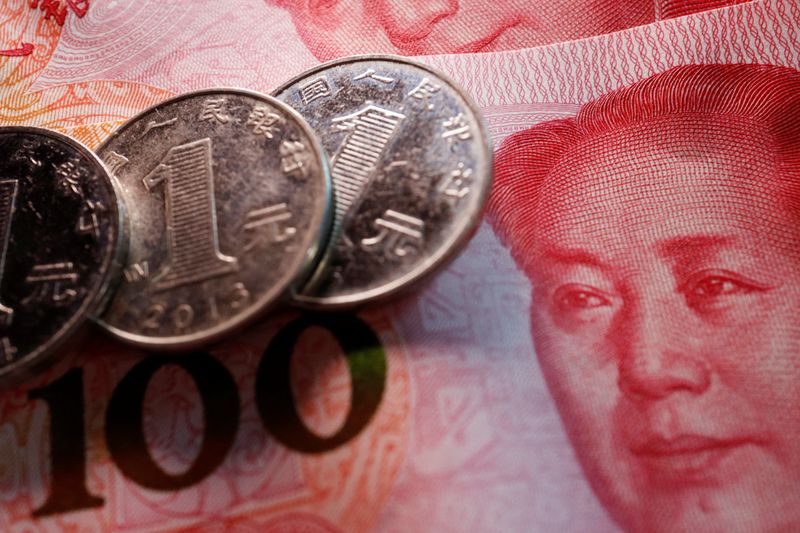By Winni Zhou and Alun John
SHANGHAI/HONG KONG (Reuters) - Major investment houses are cutting their forecasts for the yuan for the second time in just three weeks as the Chinese currency's recent sharp declines tore through their previous revisions, catching many off guard.
A triple whammy of slowing growth, COVID-19-related economic disruptions and aggressive U.S. Fed tightening has put strong downward pressure on the yuan, while Chinese authorities appear to be standing aside to let their tightly managed currency drop.
The spot yuan rate has tumbled more than 6% against the dollar in the last four weeks and was at 6.7992 per dollar on Monday, busting past the 6.71 median year-end forecast in a poll of nine banks in late April.
Several banks now see the yuan weaking to 6.9 or even hitting the 7 mark before the end of the year, levels not seen since the early stage of the pandemic in 2020.
HSBC said in a note that the currency had become stretched, "especially against the backdrop of China's economy slowing and the Fed remaining firmly hawkish.
"Neither are new developments per se, but things have become more intense, which we believe warrants consideration for our forecasts."
HSBC, cutting its yuan forecast for the second time in three weeks, now expects the yuan to trade at 6.75 per dollar at the end of the second quarter before bouncing to 6.70 at the end of Q3, compared with 6.60 and 6.62, respectively, after its previous revision.
The late April poll of nine banks had projected the yuan at 6.63 per dollar at the end of June, according to the median forecast. A majority of respondents expected the yuan to weaken further to 6.71 towards the year-end.
But the yuan's latest fall, to its lowest in nearly 20 months and a rare gyration for a currency that has typically been tightly managed within a thin range, has led many analysts to project further weakness.
A slew of weaker-than-expected April economic data released on Monday and last week, including credit lending, retail sales and industrial output, reaffirmed market views that the world's second-largest economy faces mounting headwinds as COVID-19 lockdowns take a heavy toll.
"USD/CNY could rise fast to 7 if onshore COVID situations worsen with more lockdowns followed by severe supply chain disruptions," Barclays (LON:BARC) said in a note.
The bank also noted the possibility, however, that the yuan could quickly retrace if authorities step in to prop up the currency or to bolster the economy.
"The downside risk comes from the People's Bank of China (PBOC) leaning aggressively against further CNY weakness and a sharper decline in dollar than we expected; risk sentiment could also boost CNY in the case of massive stimulus. In this case, USD/CNY could see quick retracement to 6.70."
Barclays lowered its yuan forecasts to 6.9 per dollar at end-Q2 from 6.3 previously, to account for a stronger dollar and foreign portfolio outflows.
Others, including Mizuho Bank and UBS, also trimmed their yuan projections to reflect bearish sentiment.
Ken Cheung, chief Asian FX strategist at Mizuho Bank, cut his year-end yuan forecast for a second time on Monday to 6.7 from 6.6.
Wang Tao, chief China economist at UBS, revised her year-end yuan forecast to 6.9 from 6.6 previously.
"USD/CNY may break 7 before end-year due to USD strength and a likely sharp weakening of China's exports and general economy, but should settle below 7 by year end," she said.
"This is because we expect the COVID-related economic impact to decline in the second half of the year, with growth momentum rebounding and market confidence improving."
